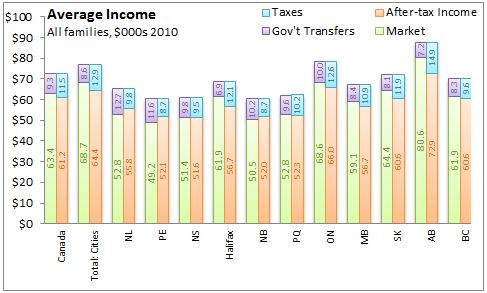The Economics and Statistics Division maintains archives of previous publications for accountability purposes, but makes no updates to keep these documents current with the latest data revisions from Statistics Canada. As a result, information in older documents may not be accurate. Please exercise caution when referring to older documents. For the latest information and historical data, please contact the individual listed to the right.
<--- Return to Archive
For additional information relating to this article, please contact:
June 18, 2012INCOME DISTRIBUTION IN NOVA SCOTIA ` Statistics Canada has released its latest publication on Income in Canada. This report provides the results of the 2010 Survey of Labour and Income Dynamics. This provides measures of average income, income distribution and incidence of low income.

Statistics Canada uses three concepts to measure income:
- Market income is earned from work, self-employment and investment/retirement products
- Total income from all sources is measured by adding government transfers to market income
- Taking income taxes (provincial + federal) away from total income yields after-tax income
Nova Scotia's average family market income was $51,400 in 2010. This is $12,000 less than the Canadian average of $63,400. Halifax family income from market sources is much closer to the national average at $61,900. Government transfers of $9,800 increase average Nova Scotia income from all sources to $61,200. Canadian government transfers of $9,500 raise average income from all sources to $72,700. Nova Scotians pay an average of $9,500 in taxes, leaving average after-tax income of $51,600. Canadian families pay more in taxes ($11,500), but higher market income leaves Canadian families with after-tax income almost $10,000 higher than in Nova Scotia ($61,200).

Nova Scotia continues to reduce the percentage of individuals living in low income. In 2010, 7.7 per cent of Nova Scotians had income below the low-income cut-off. This continues the improvements observed since 2008. The incidence of low income in Nova Scotia continues to be below the national average.

The pattern of income distribution in Nova Scotia is similar to previous observations. Compared with the national average, Nova Scotia has a greater share of families with income that ranges from $0-$30,000 and a similar share with income between $30,000-$60,000. A relatively smaller portion of the Nova Scotia population has family income from $60,000-$100,000 and above $100,000. In comparison, there are fewer Ontario and Alberta families in the lower income ranges and more in the higher income ranges.
Statistics Canada, Income of Canadians, 2010
<--- Return to Archive